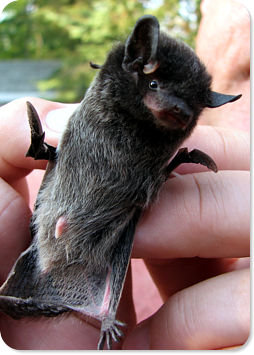 A Silver-haired Bat that got into our cottage on another occasion. A Silver-haired Bat that got into our cottage on another occasion.Bat flying in cabin was opportunity for friendly encounter.(Published in the Winnipeg Free Press, Jul. 29, 2001) I felt a foot in my back, then heard the rhetorical, "Are you awake?" "MmMmMm?", was my response; that's my usual reply when awoken from sleep in the wee hours, especially at the cottage where I sleep soundly and deeply. "There's some big moth flying around in here. A great big thing, whippin' around in a circle. I think it landed on me once", said my wife in the tone I recognized to mean, "Get up and do something about it". I turned and lay on my back. The night light in the living room, still a necessity with young kids around, cast some light into our bedroom. Ah yes . . . now my eyes were focussing and, sure enough, there was something circling over us. It took me about a second to realize what it was. "Hmmm", was my initial reply. I needed a couple more seconds to decide if I should tell her what it was. She's pretty good about these sort of things now, being married to a biologist, but you never can tell how someone's going to react in a novel situation. Then, almost gleefully, I whispered, "It's not a moth". "Then what is . . . Oh!, . . . Ick!", and with that she was gone, under the blankets. "Yes", I said, thinking she had done well to have made the appropriate assumption, "it's a bat." "Oh, no!", followed by muffled, nervous laughter came from beneath the covers, "What are you going to do?" What was I going to do? Why, what I always do in situations like this: catch the critter, show it off to the kids, then let it go. A quick slink to the porch to get my butterfly net, a view missed swipes, then "swoop", I had him, and into an empty aquarium he went for the rest of the night. The little fellow, at least I think it was a male, was a "little brown bat" (Myotis lucifugus), one of 6 kinds of bats that live in Manitoba. I knew we had some little brown's living under the eaves of our cottage, though how one had gotten inside remains a mystery. Like mice, which they are not even closely related to, bats can squeeze through very tiny openings. Of our 6 kinds of bats, 3, including the little brown, could best be described as just that, "little brown bats". The other brown bats are the big brown bat (Eptesicus fuscus) and the Keen's bat (Myotis keenii). These 3 are rather hard to tell apart, for a "non-bat expert". They range in wing span from about 20 cm to 33 cm. Even the big brown bat, the largest of the 3, is pretty small, weighing less than 20 gm. These 3 bats stay here year-round, spending winters in caves below the frost line. Our other 3 bats are easy to identify, if you have one in hand. The silver-haired bat (Lasionycteris noctivigans) has long silvery tips to its fur that stick out from a mostly black background colour. It's about the size of a big brown bat. Hoary bats (Lasiurus cinereus) are grey-brown with longer, white-tipped hairs that give them a grizzled, "hoary" appearance. They're the giant of the group with a wingspan of up to 43 cm. And finally, there's the red bat (Lasiurus borealis) which is smaller than the hoary, but has red-tipped hairs instead of white, so it has a rusty red caste to it. These 3 species migrate to warmer climes for the winter, just like most of our birds. In the morning after the nocturnal netting, when my kids were up, and all the neighbours' kids had been rounded up, plus a few of the less squeamish adults, we had an impromptu interpretive talk and bat-release. Getting people to care about bats isn't that hard, once they've seen one up close. These tiny creatures loose a lot of their horror film image when they're curled up in the palm of someone's hand. When released the little fellow took off, well, like a bat out of you-know-where and disappeared into the forest, but I'm sure the memory of seeing and touching that little animal will last for those of us fortunate enough to have had a bat in hand. Thanks for reading! Got to the: < Previous Column | What's Outdoors Front Page | Next Column >
|
||
| You can help NatureNorth produce more great articles with a secure donation through PayPal. Our Google Adsense ads pay our server costs, but that's about it. To learn more follow this link: Support NatureNorth. Thank-you! | |
Return to the: NatureNorth.com Front Page
Or pick a seasonal issue to visit:
